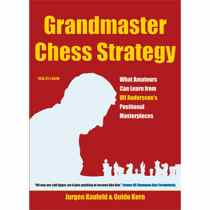Grandmaster Chess Strategy
What Amateurs Can Learn from Ulf Anderssons Positional Masterpieces
Guido Kern, Jurgen Kaufeld

The authors feel that one of the best ways to improve is to choose a chess hero and then to analyze his games in depth. In this way youll come to understand his specific style and the components of his game that helped him reach his lofty status.
The hero in this case is the Swedish Grandmaster Ulf Andersson, who was feared in the 70s and 80s as being someone that was almost impossible to beat, but who could easily grind other world-class players down by using his amazing positional skills and flawless technique.
I was a big fan of Anderssons during his heyday, and learned a lot about the science of positional chess from him. If this was just a collection of his games, I would be high on the book. However, the authors took things to another level by not only offering 80 of his finest games, but also making each one a lesson. The notes are simple and clear, and the writers go out of their way to explain all the key positional features so you can follow whats going on and learn from it.
Adding greatly to the instructional value are test diagrams (sometimes several in a game) where a question is asked of the reader to see if hes on top of the proceedings. A few samples of the prose contained in these test diagrams:
The next move is both prophylactic and also decisive for the future course of this endgame. What does White play?
How can black exploit the unfortunate positioning of the white pieces on the kingside?
It will certainly not be difficult for you to find the next move if you have been paying attention to our subject. But try to work out the considerations which lead to that move.
Black dominates the d-file and the important d4-square; additionally, he has a very strong bishop on b7. What is important is this position is that after castling the black king is safe and the white queen does not have anything to attack. How would you continue the game?
Blacks position is excellent. How can the rook and knight be even better deployed?
All the games are placed in chapters based on theme:
Chapter 1 Playing Against Two Weaknesses (6 games)
Chapter 2 An Advantage in Space (5 games)
Chapter 3 Control of the D-File (5 games)
Chapter 4 Prophylaxis (4 games)
Chapter 5 Playing Against the Isolated Pawn (5 games)
Chapter 6 The Bishop Pair (5 games)
Chapter 7 An Original Exchange of Bishop for Knight (4 games)
Chapter 8 Fighting Against the Hedgehog (3 games)
Chapter 9 The Positional Exchange Sacrifice (6 games)
Chapter 10 The Positional Queen Sacrifice (4 games)
Chapter 11 The Art of Defence (5 games)
Chapter 12 The Catalan Endgame (6 games)
Chapter 13 Rook Endings (10 games)
Chapter 14 Rook and Minor Piece (5 games)
Chapter 15 Minor Piece Endings (7 games)
The book concludes with a very short biography of Andersson, an Index of Games, and Index of Openings, a Key to Symbols Used, and an Index of Players.
A word about the misguided fellows who think they know what they are talking about but dont have a clue (yet they want to share their ignorance with anyone who will listen): Many of these people rave insanely about how players under 2000 should only study tactics and nothing else. This is simply wrong on many levels. The first problem is that if you dont have any positional skills you wont be able to enjoy (or understand) master games that feature anything other than basic sacrifices. The second problem is that chess strength is based on being well rounded you need a bit of everything if you want success, and if you just focus on one thing youll find that you quickly reach a limit and never progress from there. The third problem is that tactical success is largely based on setting up a positionally sound game where tactics occur naturally. If you just play random moves and hope for a lucky knockout punch, youll find youre going nowhere fast.
Personally, I feel that tactics, tactics, and more tactics are indeed what players under 1200 need. But once you master basic tactical themes it will be time to expand your horizons and absorb other kinds of lessons too (and, of course, you should continue to hone your tactical skills long after you go beyond 1200, but not to the detriment of all other chess areas). In my view, Grandmaster Chess Strategy is a fun way for players 1400 to 2200 to push aside their lizard (attacking) brain and absorb some positional niceties.
